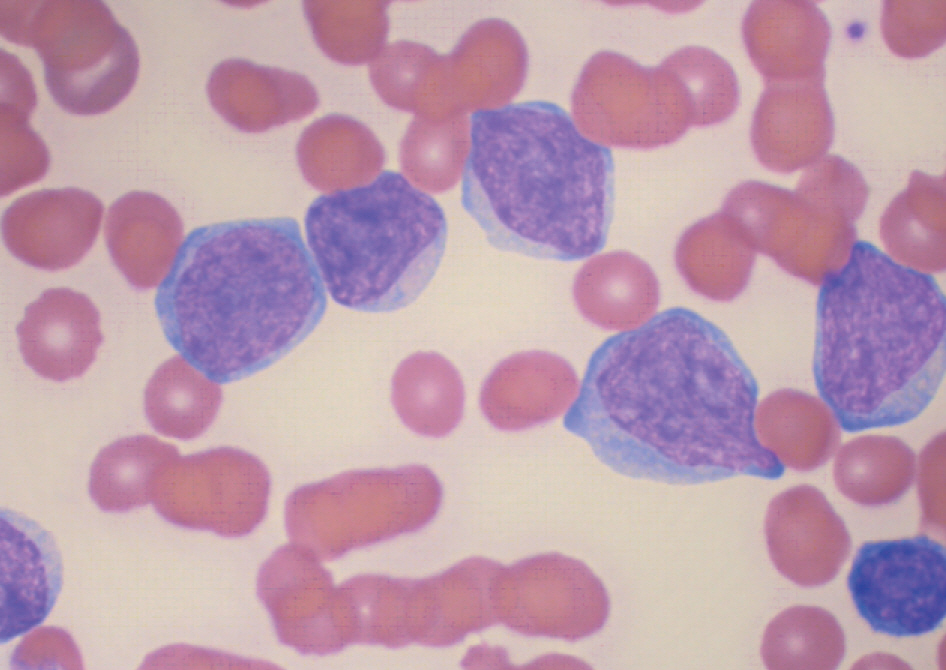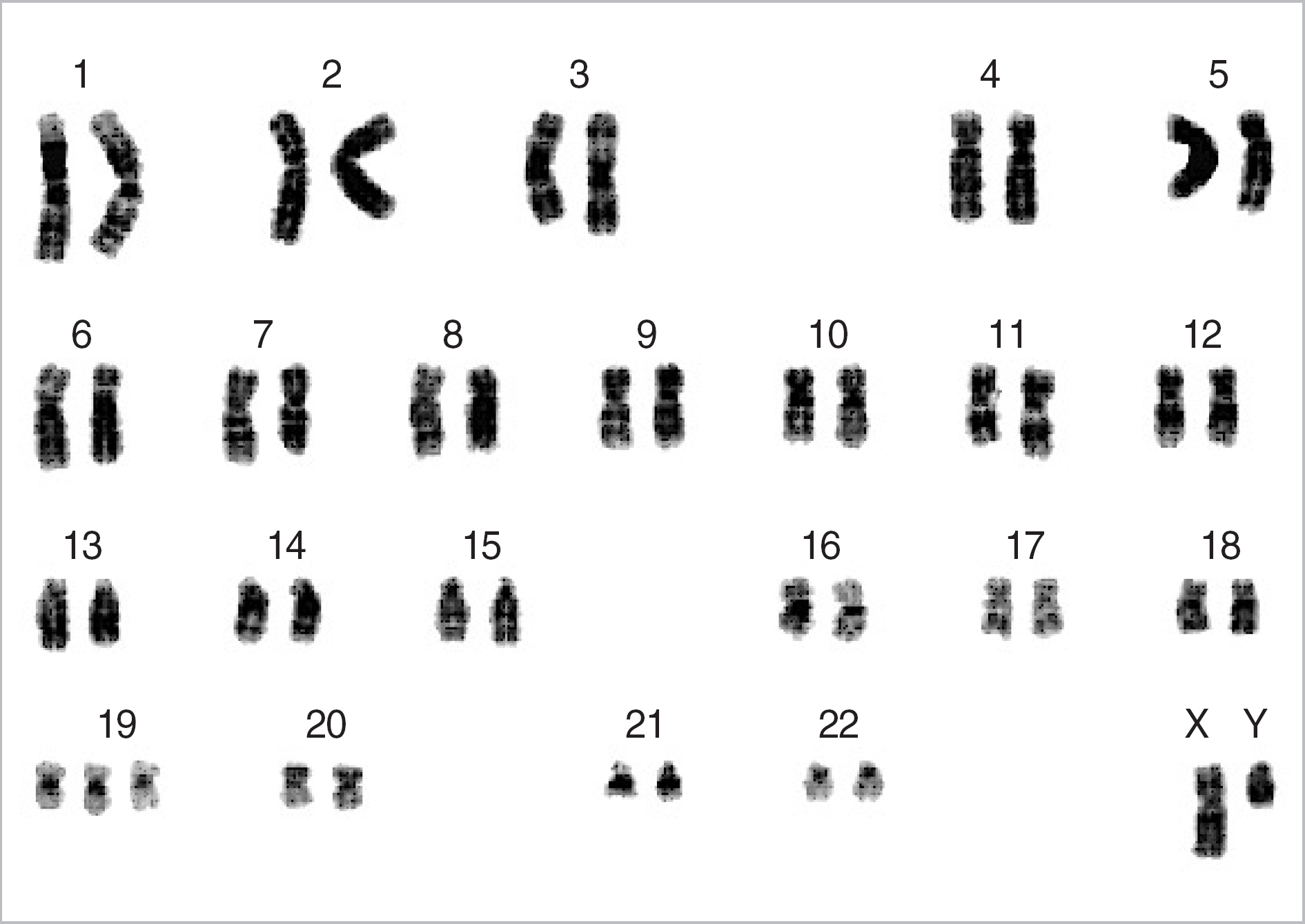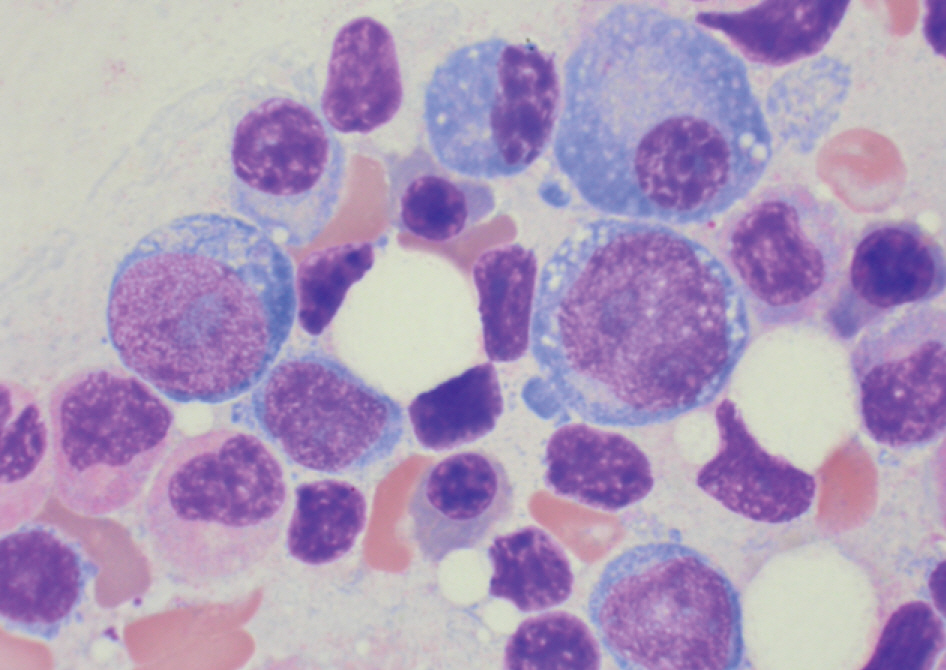Korean J Lab Med.
2008 Jun;28(3):174-178. 10.3343/kjlm.2008.28.3.174.
Two Cases of Trisomy 19 as a Sole Chromosomal Abnormality in Myeloid Disorders
- Affiliations
-
- 1Department of Laboratory Medicine, Yeungnam University College of Medicine, Daegu, Korea. chscp@med.yu.ac.kr
- 2Department of Pediatrics, Yeungnam University College of Medicine, Daegu, Korea.
- 3Department of Internal Medicine, Yeungnam University College of Medicine, Daegu, Korea.
- KMID: 854862
- DOI: http://doi.org/10.3343/kjlm.2008.28.3.174
Abstract
- Trisomy 19 is frequently encountered in cases of chronic myeloid leukemia (CML) as a secondary abnormality: however, trisomy 19 rarely occurs as a sole chromosomal abnormality and, to date, it has only been reported in 48 hematopoietic malignancies, 1 case of adenocarcinoma and 1 case of astrocytic tumor. Here, we report two additional cases of trisomy 19 as a sole karyotypic aberration in myeloid malignancies. One of these cases involved a 6-month-old male who was diagnosed with acute myeloid leukemia minimally differentiated. His karyotype was 47,XY,+19[20]. He expired 5 days after diagnosis. Another case occurred in an 80-yr-old female who had refractory anemia with excess blasts. Her karyotype was 47,XX,+19[16]/46,XX[4]. Four months later, her peripheral blood smears suggested that the disease had progressed, but she refused further evaluation. Based on a review of the existing literature and the results of this report, trisomy 19 not only as a secondary abnormality but also as a sole karyotypic aberration is strongly associated with myeloid disorder; however, it is not preferentially found in specific FAB subgroups of myelodysplasic syndrome or acute myeloid leukemia.
MeSH Terms
Figure
Reference
-
1.Primary, single, autosomal trisomies associated with haematological disorders. United Kingdom Cancer Cytogenetics Group (UK-CCG). Leuk Res. 1992. 16:841–51.2.Mitelman F., Johansson B., Mertens F. Mitelman database of chromosome aberrations in cancer. http://cgap.nci.nih.gov/Chromosomes/Mitelman. (Updated on Aug 2007).3.Johansson B., Billstrom R., Mauritzson N., Mitelman F. Trisomy 19 as the sole chromosomal anomaly in hematologic neoplasms. Cancer Genet Cytogenet. 1994. 74:62–5.
Article4.Heim S, Mitelman F, editors. Nonrandom chromosome abnormalities in cancer-an overview. Heim S, Mitelman F, editors. Cancer cytogenetics. 2nd ed.New York: Wiley-Liss Inc;1995. p. 19–32.5.Diez-Martin JL., Dewald GW., Pierre RV. Possible cytogenetic distinction between lymphoid and myeloid blast crisis in chronic granulocytic leukemia. Am J Hematol. 1988. 27:194–203.
Article6.Nimer SD., MacGrogan D., Jhanwar S., Alvarez S. Chromosome 19 abnormalities are commonly seen in AML, M7. Blood. 2002. 100:3838.
Article7.Daskalakis M., Mauritzson N., Johansson B., Bouabdallah K., Onida F., Kunzmann R, et al. Trisomy 19 as the sole chromosome abnormality in proliferative chronic myelomonocytic leukemia. Leuk Res. 2006. 30:1043–7.8.Hartley SE., Sainsbury C. Acute leukemia and the same chromosome abnormality in monozygotic twins. Hum Genet. 1981. 58:408–10.9.Babic I., Brajenovic-Milic B., Petrovic O., Mustac E., Kapovic M. Prenatal diagnosis of complete trisomy 19q. Prenat Diagn. 2007. 27:644–7.10.Langer F., Dingemann J., Kreipe H., Lehmann U. Up-regulation of DNA methyltransferase DNMT1, 3A, and 3B in myelodysplastic syndrome. Leuk Res. 2005. 29:325–9.11.Daskalakis M., Nguyen TT., Nguyen C., Guldberg P., Kohler G., Wijermans P, et al. Demethylation of a hypermethylated P15/INK4B gene in patients with myelodysplastic syndrome by 5-Aza-2′ -deoxycytidine (decitabine) treatment. Blood. 2002. 100:2957–64.
- Full Text Links
- Actions
-
Cited
- CITED
-
- Close
- Share
- Similar articles
-
- Trisomy 9, As a Sole Chromosomal Aberration in Refractory Anemia with Excess Blasts-II
- Sole Trisomy 22 Not Associated with inv(16) in Myelodysplastic Syndrome
- Chromosomal Analysis in Childhood Leukemia
- A Case of Pediatric Acute Lymphoblastic Leukemia with Trisomy 5 as a Sole Chromosomal Anomaly: A Prognostic Significance
- Cytogenetic Findings in Patients with Acquired Aplastic Anemia




